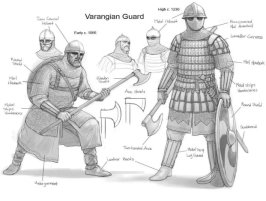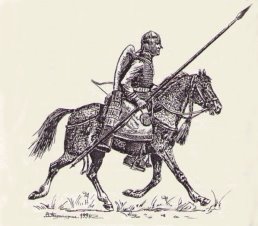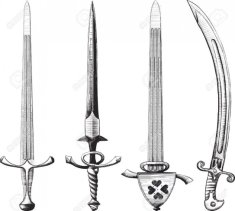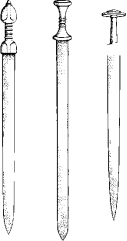The army is one of the main elements of the state and society, a good source of career opportunities. The problem associated with the army has been relevant since ancient times. At present, the army is as important as in the distant past. It was used both in internal affairs (protection of territories), and in external (various wars).
The Byzantine infantry of the 4th-5th centuries was traditionally represented by psilahs — the generic name of lightly armed soldiers who do not wear protective equipment, literally — “bald” (Appendix 3).
«Toxophoreters worn over the shoulders, with large quivers holding 30 or 40 arrows; small shields; wooden solenarias with small arrows and small quivers, which are used for firing at long range from bows that harass enemies. Berits and darts of the Skleven type those who don’t know how to shoot from bows, Marsobarbul, worn in leather cases, slings”- this is how Mauritius Stratig described the armament of the psilo infantrymen [1].
The guards of the Byzantine army were armed with a heavy two-handed Danish ax. This ax was a powerful weapon, deadly effective in the hands of an experienced fighter. The Varangian Guard of the early (left) and later period is shown in the figure (Appendix).

Lighter types of battle axes of the early Byzantine period were used as throwing weapons.
The main weapon of the cavalry and infantry was a spear. The heavy spear (contarion) was a two-meter peak, used by heavy infantry, scooters, to fight enemy horse fighters. For throwing and close combat, the Byzantine army infantrymen used lighter spears. The figure depicts the use of a spear by a cavalryman and a Byzantine harness (Appendix).

Byzantine infantry used swords as secondary weapons. The figure shows the paramerion (Greek — near + hips) — a Byzantine saber-shaped weapon, with a curved blade, with a total length of about 90 cm (Appendix).

Another type of sword — spatha (a straight and long double-edged sword, measuring from 75 cm to 1 m, used according to the VI century AD) is depicted in the figure (Appendix).

The heavy cavalry of the Byzantine army, cataphracts, intended for use as a striking force of force, if necessary, used both types of swords at once.
One of the most obvious trends in battle tactics of the VI century became the widespread use of throwing weapons. Effective light infantry weapons for that period were slings and metal darts.
A sling is a primitive in appearance, but brilliant, in fact, a device for throwing stones. Military authors of the 6th century recommended the use of a sling by an entire warrior, especially a lightly armed one. The sling rotated above the head with one hand, after which the stone was released towards the target. It was used both during siege and defense [4].
Aconist (άκόντιον — dart). According to Vegetius, psilas, dart throwers of the youngest call were called aconists.
Plumbata mamillata is a long throwing shaft, a metal dart 20–25 cm long, with a spherical lead ball at one end, ending with a sharp tip, and feathers at the other end of the dart (Appendix).
The first mention of the plumbata we can find in the anonymous treatise «On Military Affairs» and the composition of Vegetius «Summary of Military Affairs». A description of the appearance and method of use of various types of plumbata was also left by an anonymous author “On Military Affairs”, describing in detail how to use this weapon.
Such weapons provided light infantry and archers mobility and maneuverability in battle. Bows originally made according to the European model, over time, were replaced by similar ones used by the Ottoman Turks [3].
The complex two-part Romanesque bow was 100–125 cm long, according to iconography. Such weapons can be seen on the mosaic of the Grand Imperial Palace, the mosaic from the Basilica of Moses and on the Egyptian ivory plate, the sixth century pixids from the Vienna Museum of Art. The recommendations of the theoretic stratig were that the psil should have a large supply of arrows. Traditionally, there were 30–40 arrows in a quiver. The quiver rushed behind his shoulder, as on a sixth-century pixid from the Metropolitan Museum of Art. Mauritius wrote that the weapon must correspond to the physical capabilities of the soldier.
The shooters were in defensive armament and without it, as Fiofilakt Samokitta wrote, “they were not dressed in armor, because they did not know what they were to meet. Neither helmets covered their heads, nor a shell protected their breasts in order to ward off the iron with iron — there was this body guard that came with the guarded and accompanying him; a glorious feat made them weaken their vigilance, and the victory of heroes, strong in spirit, cannot teach caution " [2].
Technical Details of the 6th Century Byzantine Bow were borrowed from the northern nomads, the Sarmatians and the Huns. It was complex, parts of it were made up of horns.
The uniform of the Byzantine cavalrymen of the VI century. included Hymatias and Gunias. In the VI century Hymatium is defined as underwear, “overcoat”. An anonymous author of the sixth century wrote that protective armaments “should not be worn directly on the underbody [tunic], as some do, trying to reduce the severity of the armament, but on a hematium, no less than a finger thick, so that, on the one hand, the armament, tightly encircled the body, but at the same time did not injure him with his hard contact. ”
References:
- Bannikov A. V., Morozov M. A. the Byzantine army (IV-XII centuries) Moscow: Eurasia, 2015–688 p.
- Kuchma V. V. Military art / / Culture of Byzantium. IV-1st floor. VII V. M., 1984. -407 p.
- Vashchenko E. Light infantry of Byzantium VI century. Access code — https://topwar.ru/159257-legkaja-pehota-vizantii-vi-veka.html — date of access 4.08.2019
- Vashchenko E. Mounted Riflemen of the Byzantine army of the VI century. Access code — https://topwar.ru/158607-konnye-strelki-vizantijskoj-armii-vi-v.html — date of access 4.08.2019







